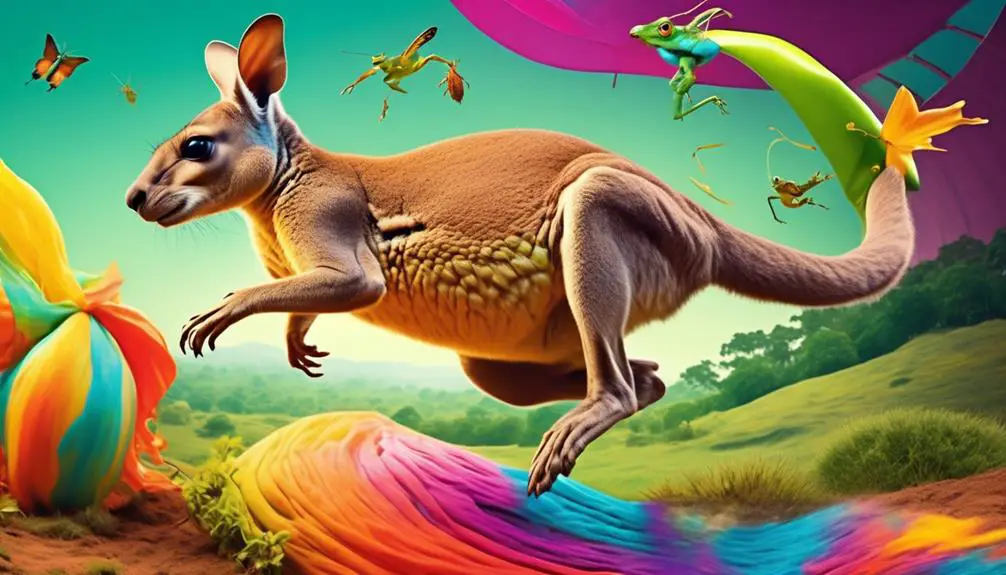Have you ever watched a frog gracefully hop from one lily pad to another, effortlessly defying gravity? It’s a sight that never fails to captivate our curiosity. But the world of hopping and jumping animals goes beyond just frogs.
From the bouncy kangaroo to the agile grasshopper, these creatures have evolved remarkable abilities to navigate their environments. And while their jumping prowess may seem like a mere display of athleticism, there’s much more to uncover.
In this discussion, we’ll explore the secrets behind their astonishing leaps, the reasons why they’ve honed this skill, and the impact they have on their ecosystems. Get ready to hop into the fascinating world of animals that defy gravity!
Primary Jumping Animals
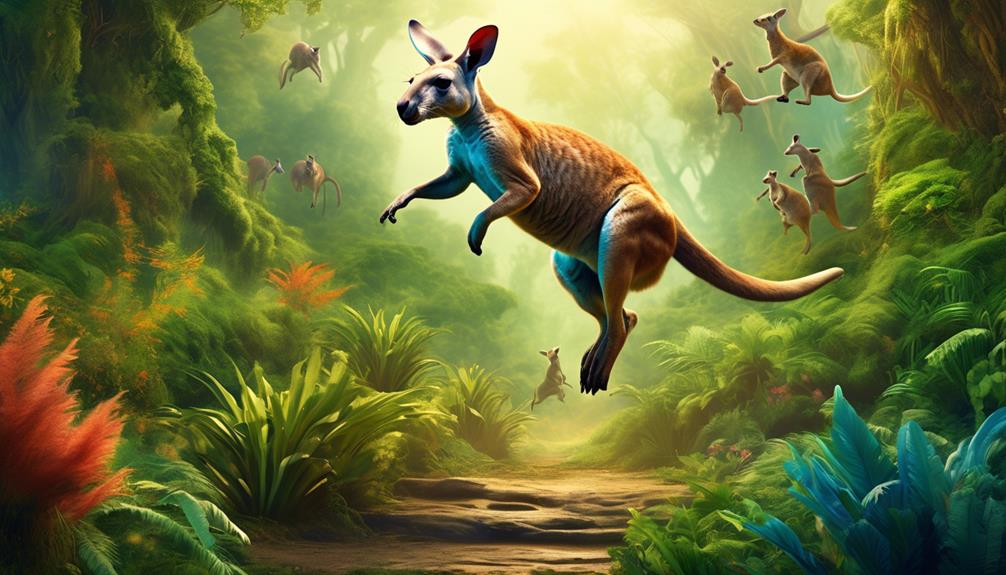
Jumping is the primary form of movement for several animal species, allowing them to efficiently travel, catch prey, and escape predators. Frogs rely on jumping as their primary form of movement, propelling themselves through the air with their powerful hind legs. Kangaroos, known for their incredible hopping ability, use jumping as an energy-efficient method of travel. Jumping spiders, with their leaping ability, can catch prey and escape predators with ease. Grasshoppers, on the other hand, use their power to hop and fly away to survive.
These animals exhibit impressive jumping abilities. Deer can cover ground up to fifteen feet in length and eight feet in height with their jumps. The South African Sharp-Nosed frog can make massive jumps reaching 130 inches. Kangaroos, with their long hind legs, can make huge leaps of over 9 meters. Hares can soar up to 10 feet from the ground when leaping, while ostriches can jump as far as 16 feet using their powerful back legs.
Jumping also serves as a defense mechanism for many animals. Deer use jumping as a defense mechanism against predators, leaping away from danger. Frogs use their jumping ability to quickly escape predators. Wallabies, similar to kangaroos but smaller in size, use short bursts of hopping to evade predators. Crickets, with their remarkable method of escape, survive predators by leaping away.
Impressive Jumping Abilities
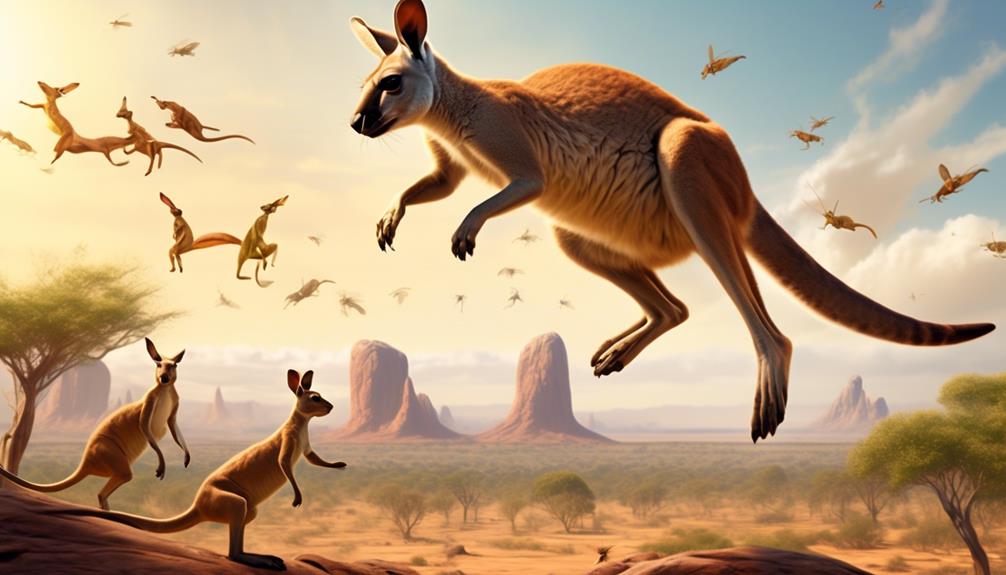
Prepare to be amazed by the extraordinary leaping abilities of certain animals.
These creatures possess remarkable speed, agility, and the power to cover impressive distances with their jumps.
From kangaroos leaping over 9 meters in a single bound to deer soaring up to 15 feet in length and 8 feet in height, their jumping prowess is truly awe-inspiring.
Extraordinary Leaping Distances
With their incredible jumping abilities, certain animals can cover impressive distances in a single leap. Take a look at the table below to see some examples of extraordinary leaping distances achieved by different species:
| Animal | Leaping Distance |
|---|---|
| Deer | Up to 15 feet |
| South African Sharp-Nosed Frog | Up to 130 inches |
| Kangaroo | Over 9 meters |
| Hare | Up to 10 feet |
| Ostrich | Up to 16 feet |
These distances highlight the remarkable power and agility of these animals. Whether it’s the deer leaping gracefully through forests, the kangaroo bounding across the open plains, or the ostrich propelling itself forward with its strong legs, each species has adapted unique jumping abilities to navigate their environments. These extraordinary leaping distances allow them to cover great distances in search of food, escape from predators, or find suitable habitats. It’s truly awe-inspiring to witness the sheer athleticism and precision of these animals as they propel themselves through the air.
Remarkable Speed and Agility
The remarkable speed and agility displayed by animals with impressive jumping abilities is truly awe-inspiring. These creatures have evolved unique adaptations that allow them to move with incredible swiftness and precision.
Kangaroos, for example, are known for their ability to jump on two legs at speeds of up to 70 km/h, covering great distances in a single bound. Hares, on the other hand, can sprint at speeds of up to 80 km/h, using their powerful hind legs to propel themselves forward.
Crickets and grasshoppers exhibit impressive jumping abilities as well, with the former being able to jump about 3 feet in length and the latter capable of leaping up to 30 inches across. These animals rely on their exceptional speed and agility to escape predators, find food, and navigate their environments with remarkable efficiency.
It’s truly remarkable to witness the agility and speed at which these animals move through their natural habitats.
Jumping as a Defense Mechanism
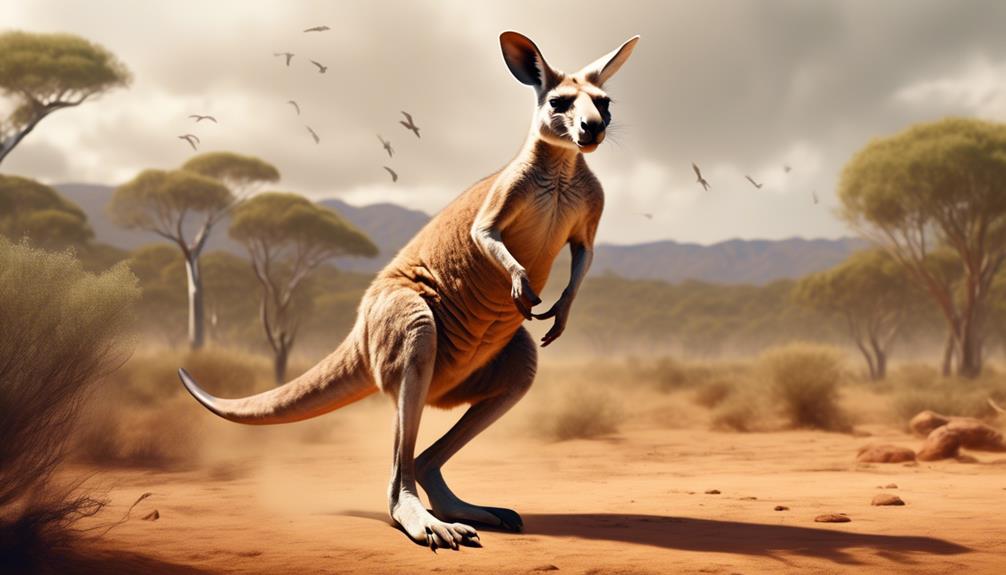
Jumping as a defense mechanism is a common strategy used by many animals to evade predators and ensure their survival. By utilizing their remarkable agility and ability to leap great distances, animals such as frogs, kangaroos, and wallabies can quickly escape from potential threats.
Jumping allows these animals to create distance between themselves and predators, increasing their chances of safety and survival in their respective habitats.
Predator Evasion Tactics
In their quest for survival, animals employ various tactics to evade predators, and one effective strategy involves harnessing their impressive jumping abilities.
Jumping as a defense mechanism allows animals to quickly escape from potential threats and gain distance to ensure their safety. This evasion tactic is particularly useful for animals with strong hind legs and powerful muscles, such as kangaroos and hares.
By springing into the air, these animals can cover large distances in a single leap, making it difficult for predators to catch up to them. Additionally, jumping allows animals to navigate through their environment more efficiently, utilizing obstacles like rocks or bushes to create distance and obstruct the predator’s path.
Survival Through Agility
Animals with remarkable agility rely on their impressive jumping abilities as a vital defense mechanism in the wild. These agile creatures have evolved specialized adaptations that allow them to escape from predators and ensure their survival. Their ability to leap great distances and heights enables them to quickly evade danger and find safety in their environments.
| Animals | Defense Mechanism | Examples |
|---|---|---|
| Frogs | Escaping predators through rapid jumps | Tree frogs, poison dart frogs |
| Kangaroos | Using powerful hind legs to kick predators | Red kangaroos, eastern grey kangaroos |
| Wallabies | Hopping away from predators | Agile wallabies, brush wallabies |
| Grasshoppers | Jumping and flying to avoid capture | Locusts, lubber grasshoppers |
These animals have developed incredible muscular strength and coordination to execute their impressive jumps. Frogs use their powerful hind legs to launch themselves into the air, while kangaroos rely on their long and strong hind limbs to propel themselves forward. Wallabies, smaller relatives of kangaroos, utilize short bursts of hopping to quickly escape from predators. Grasshoppers, on the other hand, possess specialized hind legs that allow them to hop and even fly away to survive.
Jumping for Safety
Using their remarkable jumping abilities, certain animals employ jumping as a defense mechanism to evade predators and ensure their safety in the wild. Jumping allows these animals to quickly escape dangerous situations and find safety in their surroundings.
Frogs, for example, rely on their powerful leg muscles to propel themselves into the air and away from predators. Their ability to jump great distances and heights makes them difficult to catch.
Similarly, kangaroos use their strong hind legs to leap away from potential threats, reaching impressive speeds of up to 70 km/h. This enables them to outrun predators and find refuge in their natural habitats.
Unique Jumping Behaviors
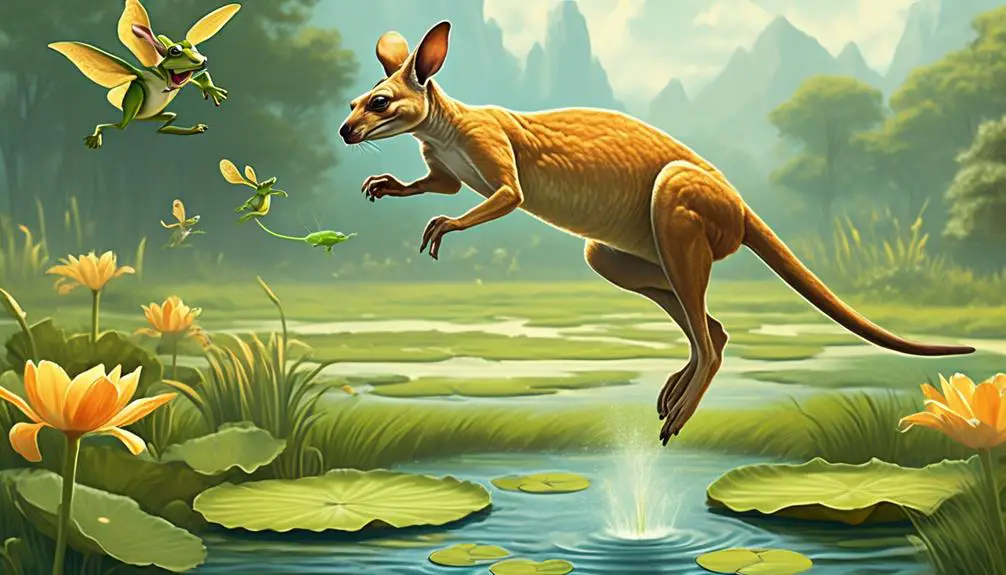
Salmon exhibit a unique jumping behavior, using their impressive leaping ability to overcome rapids as they swim upstream towards their spawning grounds. This behavior is crucial for their survival and reproduction. With their streamlined bodies and powerful muscles, salmon are able to propel themselves out of the water and navigate through challenging rapids. Their jumps can reach remarkable heights and distances, allowing them to bypass obstacles and continue their journey upstream.
The jumping behavior of salmon is a remarkable adaptation that enables them to overcome the strong currents and obstacles they encounter in their migration. By leaping out of the water, they’re able to gain momentum and propel themselves forward, effectively bypassing the turbulent rapids. This behavior requires precise timing, strength, and agility.
The ability of salmon to jump is attributed to their muscular bodies and the unique structure of their tails. They’ve strong muscles that allow them to generate the force needed for their powerful leaps. Additionally, their tails are specially adapted with strong, flexible fin rays that provide them with the necessary propulsion and stability during their jumps.
Salmon jumping not only allows them to overcome rapids, but it also serves other important purposes. It helps them evade predators such as bears and eagles that wait for them at the water’s edge. By leaping out of the water, salmon can avoid being caught and continue their journey to their spawning grounds.
Speed and Distance of Jumps
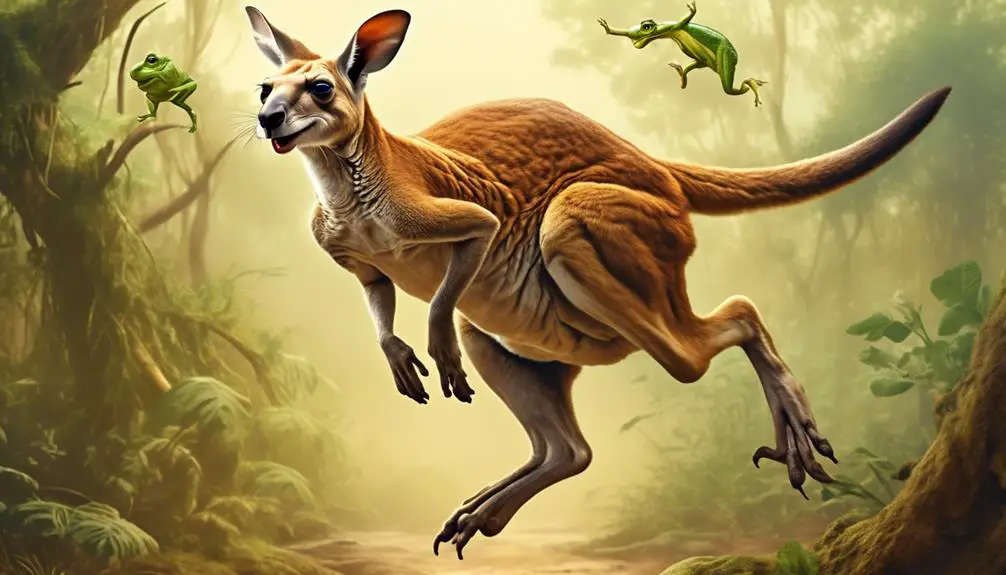
The speed and distance of jumps vary among different animals that rely on jumping as their primary form of movement. Kangaroos, for example, are known for their impressive jumping abilities. They can reach speeds of up to 70 km/h while jumping on two legs. Hares, on the other hand, can sprint at speeds of up to 80 km/h, utilizing their powerful hind legs for propulsion. Crickets, although smaller in size, can still jump about 3 feet in length, while grasshoppers can cover distances of up to 30 inches in a single leap.
These animals have adapted various anatomical features to enhance their jumping capabilities. Kangaroos, for instance, have powerful hind legs and a flexible spine that allow them to hop efficiently. They also use their tail as a pivot point for propulsion. Hares, with their long hind legs, are built for speed and agility, enabling them to cover large distances with each jump. Crickets and grasshoppers possess strong hind legs that propel them into the air, allowing for quick escapes from predators.
Understanding the speed and distance of jumps in these animals provides valuable insights into their locomotion strategies and survival techniques. By studying their unique adaptations and physical capabilities, researchers can gain a deeper understanding of the ecological roles these jumping animals play in their respective habitats.
Anatomy and Adaptations for Jumping
To understand the impressive jumping abilities of kangaroos, it’s essential to explore their specialized anatomy and adaptations for jumping.
Kangaroos have powerful hind legs and tails that provide balance and counter-movement while jumping.
Their flexible spines allow for efficient hopping, and they use their tails as pivot points for propulsion.
These anatomical features, along with their specialized digestive system for breaking down tough vegetation, contribute to the kangaroo’s remarkable jumping mechanics.
Kangaroo’s Jumping Mechanics
With powerful hind legs, a flexible spine, and a specialized digestive system, kangaroos are anatomically and adaptively equipped for their impressive jumping mechanics. Their hind legs are developed with long, strong muscles that provide the necessary power and propulsion for jumping. The kangaroo’s tail acts as a pivot point, aiding in balance and propulsion during each leap. Additionally, their flexible spine allows for efficient hopping, absorbing the shock upon landing. This enables kangaroos to cover long distances with minimal energy expenditure. Furthermore, their specialized digestive system allows them to efficiently break down tough vegetation, providing the energy required for sustained jumping. Overall, the kangaroo’s unique anatomy and adaptations make it a highly efficient and skilled jumper.
| Anatomical Feature | Function | Adaptation |
|---|---|---|
| Powerful hind legs | Provide power and propulsion | Enables long, powerful leaps |
| Flexible spine | Facilitates efficient hopping | Absorbs shock upon landing |
| Specialized digestive system | Efficiently breaks down tough vegetation | Provides energy for sustained jumping |
Specialized Anatomy for Jumping
Specialized adaptations in the anatomy of jumping animals allow for efficient and powerful movement through the air. These adaptations vary among different species, but they all contribute to the animal’s ability to jump with precision and agility.
One key adaptation is the development of powerful hind legs, which provide the necessary force to propel the animal off the ground.
Additionally, animals that excel at jumping often have a flexible spine, enabling them to generate maximum power and control during their leaps.
Another important adaptation is the presence of specialized muscles and tendons, which store and release energy rapidly, allowing for quick and explosive movements.
These anatomical adaptations work together to ensure that jumping animals can navigate their environments effectively and achieve impressive heights and distances in their jumps.
Kangaroo Behavior and Social Structure
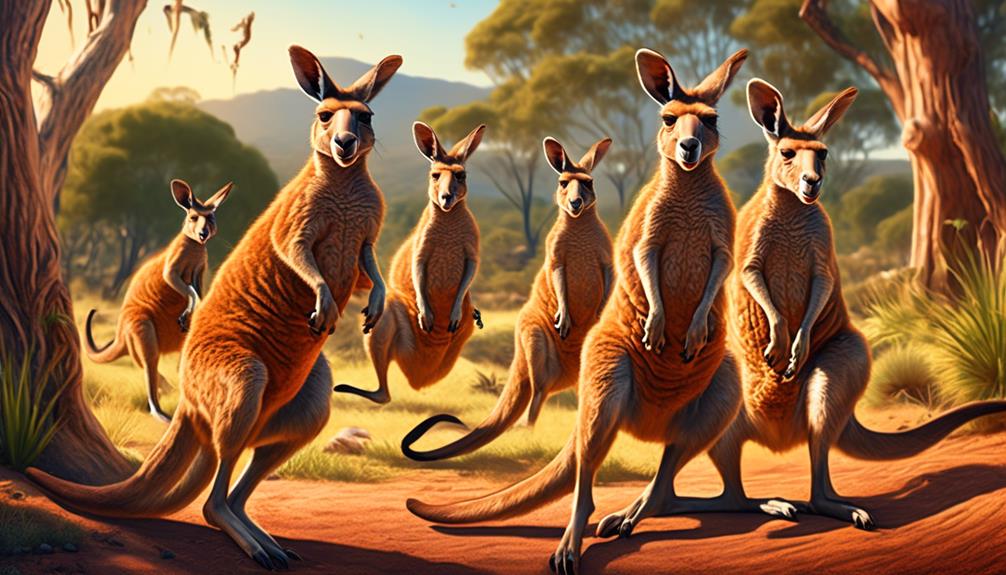
Kangaroo behavior and social structure are characterized by living in groups called mobs and exhibiting hierarchical organization. Within a mob, kangaroos establish a social hierarchy through various behaviors and interactions. Males engage in boxing matches to establish dominance, with the winners earning the right to mate with females. Communication among kangaroos occurs through vocalizations and body language, allowing them to convey information about their intentions and social status.
Cooperative behavior is also evident within kangaroo mobs, particularly when it comes to caring for their young. Female kangaroos, known as does, carry their undeveloped young, called joeys, in their pouches. The joeys remain in the pouch until they’re fully developed and able to survive outside. During this time, the does provide nourishment and protection for their offspring.
Kangaroos face predation from predators such as dingoes, foxes, and large birds of prey. To defend themselves, kangaroos rely on their powerful legs and deliver powerful kicks to fend off attackers. Their speed and agility also play a crucial role in escaping from predators.
Understanding kangaroo behavior and social structure is essential for their conservation and management. Conservation efforts focus on protecting their natural habitats and ensuring sustainable kangaroo harvesting practices. Kangaroos play a vital role in maintaining ecosystem balance, making their preservation crucial for the overall health of their habitats.
Kangaroo Predators and Defense Mechanisms
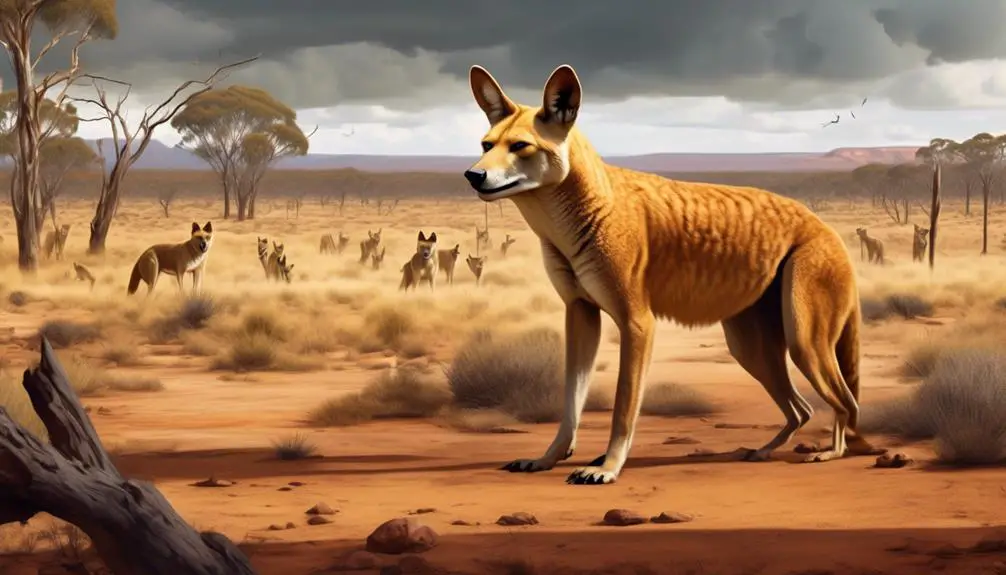
Kangaroos, as prey animals, have developed various defense mechanisms to protect themselves from their predators in the wild. They rely on their powerful legs and agility to defend against attacks and escape from danger. Kangaroos are known for their exceptional ability to deliver powerful kicks, which they use to fend off attackers. Their strong hind legs allow them to deliver these kicks with great force, making them formidable opponents. In addition to their kicks, kangaroos also use their speed and agility to outmaneuver predators. They can reach speeds of up to 70 km/h (43 mph) on two legs, allowing them to quickly evade capture.
To give you a better understanding of kangaroo defense mechanisms, here is a table outlining their key predators and the corresponding defense mechanisms they employ:
| Predator | Defense Mechanism |
|---|---|
| Dingoes | Powerful kicks |
| Foxes | Speed and agility |
| Large birds of prey | Speed and agility |
Kangaroo Conservation and Importance in Ecosystems
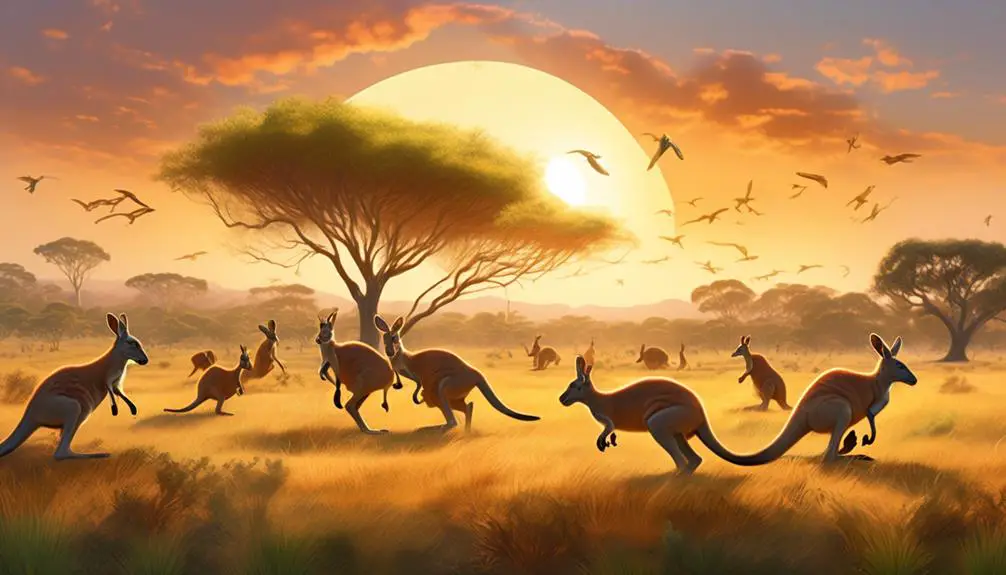
Conservation efforts for kangaroos focus on protecting their natural habitats and ensuring their crucial role in maintaining ecosystem balance. Kangaroos play a significant role in the ecosystems they inhabit. As herbivores, they help control vegetation growth, preventing overgrazing and maintaining the balance between plants and animals. Their feeding habits also contribute to nutrient cycling, as they consume plant material and release waste that enriches the soil. Additionally, kangaroos are important prey species for predators such as dingoes and large birds of prey, contributing to the overall food web dynamics.
Protecting kangaroo habitats is essential for their survival and the preservation of these intricate ecological relationships. Habitat loss due to human activities, such as urbanization and agricultural expansion, poses a significant threat to kangaroo populations. Conservation efforts focus on establishing protected areas, implementing sustainable land management practices, and promoting habitat restoration initiatives.
In some regions, sustainable kangaroo harvesting is practiced as a means of both conservation and economic benefit. By carefully managing kangaroo populations and implementing strict hunting regulations, these practices aim to maintain population levels while providing a sustainable source of meat and other kangaroo-derived products.
Kangaroo Species and Cultural Significance
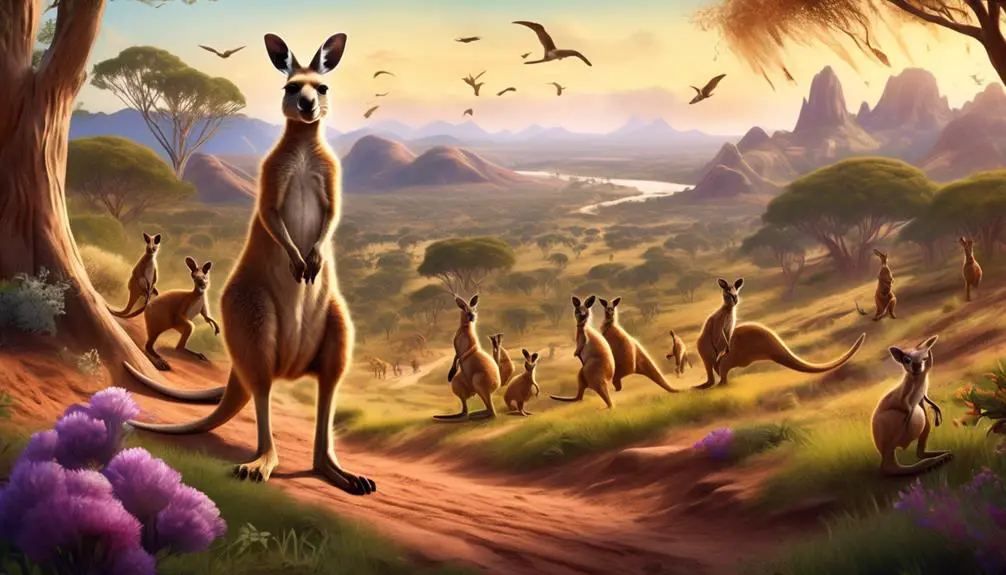
To further explore the world of kangaroos and their significance in various cultures, let’s delve into their different species and the cultural importance they hold.
Kangaroos are native to Australia and are represented by four main species: the red kangaroo, eastern grey kangaroo, western grey kangaroo, and wallaroo. Each species has its own unique characteristics and adaptations that enable them to thrive in their respective habitats.
The cultural significance of kangaroos is particularly strong in Indigenous Australian communities. Kangaroos feature prominently in Aboriginal art and mythology, symbolizing strength, agility, and resilience. They’re often depicted in paintings, sculptures, and traditional stories. In some Indigenous diets, kangaroo meat is consumed as a source of sustenance and has been a staple food for generations.
Beyond Indigenous culture, kangaroos have become iconic symbols of Australia worldwide. They’re frequently depicted in cartoons, children’s books, and serve as mascots for sports teams and organizations. Their image represents the unique wildlife and rugged landscapes of the country.
Understanding the different species of kangaroos and their cultural significance provides valuable insights into the rich biodiversity and cultural heritage of Australia. By appreciating and conserving these magnificent creatures, we can continue to celebrate their importance in both the natural world and human culture.
Kangaroo Meat and Indigenous Diets
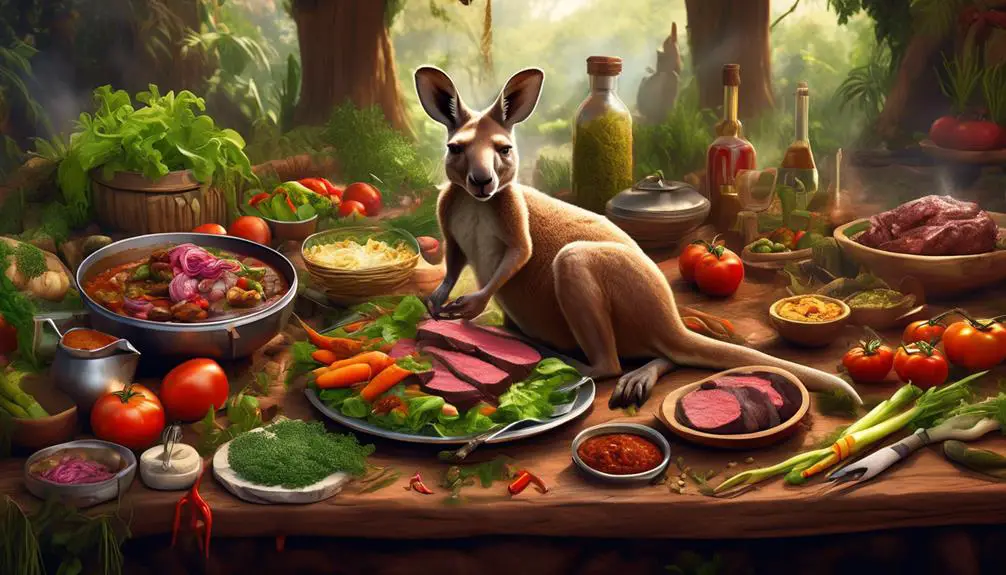
How does kangaroo meat contribute to the traditional diets of Indigenous Australians?
Kangaroo meat has long been a staple in the traditional diets of Indigenous Australians, providing a valuable source of nutrition. The meat is lean, low in fat, and rich in protein, making it an excellent dietary choice.
Indigenous communities have a deep cultural connection to kangaroos, considering them as a significant food source that has sustained them for generations. Kangaroo meat is often prepared through various cooking methods such as roasting, stewing, or barbecuing, enhancing its flavor and tenderness.
The meat is highly versatile and can be used in a wide range of dishes, including stews, stir-fries, and sausages. It’s often combined with native herbs and spices, adding a unique and distinct taste to the traditional Indigenous cuisine.
Additionally, kangaroo meat is considered environmentally sustainable, as kangaroos are abundant in Australia and their harvesting is carefully managed.
Kangaroo Popularity and Iconic Symbolism
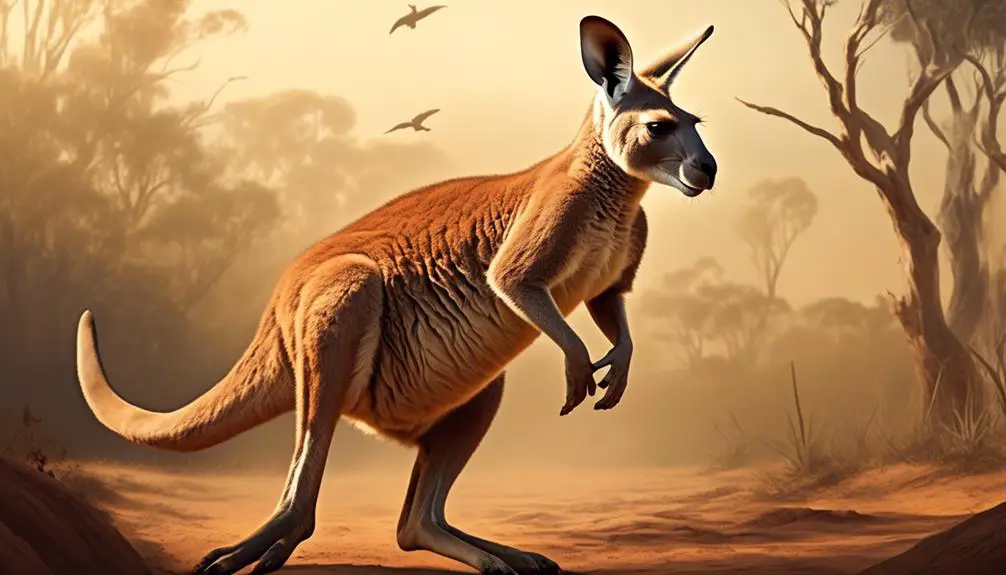
Indigenous Australians’ deep cultural connection to kangaroo meat extends beyond its role in their traditional diets, as kangaroos have become iconic symbols of Australia and hold significant cultural and popular importance.
Kangaroos are revered for their unique characteristics and behaviors, capturing the imagination of people worldwide. The kangaroo’s distinctive hopping movement has become synonymous with Australia’s identity. It’s a symbol of the country’s vast and diverse landscapes, representing its unique wildlife and natural beauty. Kangaroos are often depicted in Aboriginal art and mythology, reflecting their cultural significance to Indigenous Australians.
Beyond their cultural symbolism, kangaroos have also gained popularity in various forms of media. They’ve become beloved characters in cartoons, children’s books, and as mascots for sports teams and organizations. The kangaroo’s image is often associated with Australia’s adventurous spirit, resilience, and strength.
Furthermore, kangaroos have become important ambassadors for wildlife conservation. Their iconic status has helped raise awareness about the need to protect and preserve Australia’s unique ecosystems. As a result, efforts are being made to safeguard kangaroo populations and their natural habitats.

Erzsebet Frey (Eli Frey) is an ecologist and online entrepreneur with a Master of Science in Ecology from the University of Belgrade. Originally from Serbia, she has lived in Sri Lanka since 2017. Eli has worked internationally in countries like Oman, Brazil, Germany, and Sri Lanka. In 2018, she expanded into SEO and blogging, completing courses from UC Davis and Edinburgh. Eli has founded multiple websites focused on biology, ecology, environmental science, sustainable and simple living, and outdoor activities. She enjoys creating nature and simple living videos on YouTube and participates in speleology, diving, and hiking.

